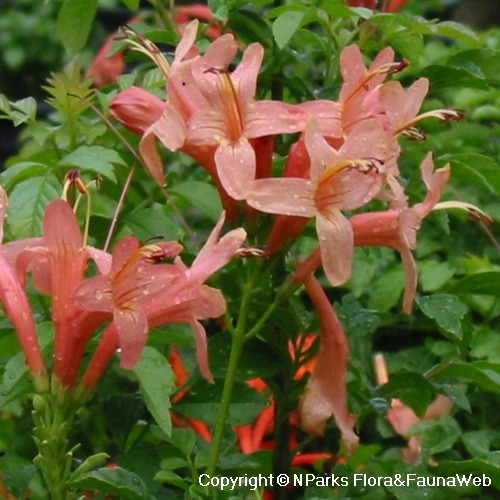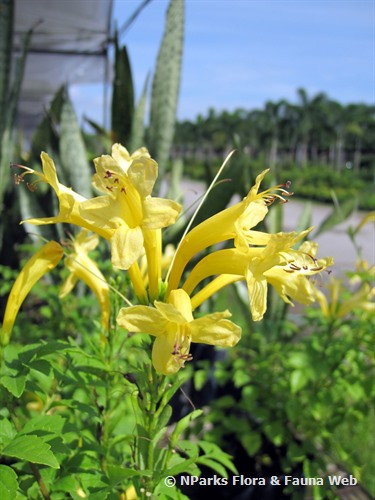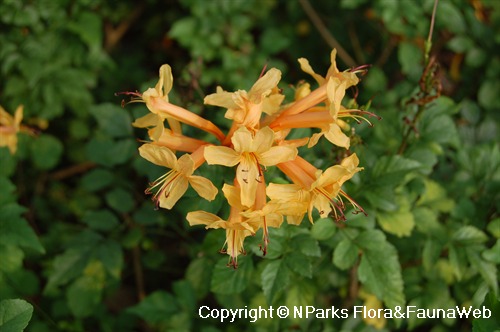
Back
Tecomaria capensis 'Apricot'
| Family Name: | Bignoniaceae |
| Synonyms: | Tecoma capensis 'Apricot' |
| Common Name: | Apricot Cape Honeysuckle |
Name
Classifications and Characteristics
| Plant Division | Angiosperms (Flowering Seed Plants) (Dicotyledon) |
|---|---|
| Plant Growth Form | Shrub, Tree (Shrubby (1m-5m)) |
| Mode of Nutrition | Autotrophic |
| Maximum Height | 1.8 m to 2.5 m |
| Maximum Plant Spread / Crown Width | 2.5 m |
Description and Ethnobotany
| Growth Form | It is an evergreen shrub and scrambling vine, growing up to 2.5 m tall. |
|---|---|
| Foliage | Leaves opposite, pinnately compound; leaflets 2-9, sessile, elliptical to ovate, measuring up to 7.5 by 3.5 cm, apex rounded, base rounded or cuneate, glabrous on both surfaces, margin serrate. |
| Stems | Stems are cylindrical, with lenticels. |
| Flowers | Flowers numerous, axillary raceme; calyx green, corolla apricot tubular. |
| Fruit | Fruits flattened, pointed at both ends, dehiscent. The fruits have seeds with transparent paper-like wing. |
| Etymology | Genus Tecoma comes from the Mexican name, tecomaxochitl. The specific epithet capensis refers to the Cape of Good Hope, South Africa. Cultivar Apricot refers to the flower colour. |
Landscaping Features
| Desirable Plant Features | Ornamental Flowers |
|---|---|
| Landscape Uses | General, Parks & Gardens, Small Gardens |
| Thematic Landscaping | Bird & Wildlife Garden |
Fauna, Pollination and Dispersal
| Fauna Pollination Dispersal Associated Fauna | Bird-Attracting, Butterfly-Attracting (Flower Nectar) |
|---|---|
| Pollination Method(s) | Biotic (Fauna) (Vertebrates (Bird)) |
| Seed or Spore Dispersal | Biotic (Fauna), Abiotic |
Plant Care and Propagation
| Light Preference | Full Sun |
|---|---|
| Water Preference | Moderate Water |
| Rootzone Tolerance | Well-Drained Soils, Saline Soils / Salt Spray, Acidic (low pH) Soils, Alkaline high pH Soils |
Foliar
| Foliage Retention | Evergreen |
|---|---|
| Mature Foliage Colour(s) | Green |
| Mature Foliage Texture(s) | Smooth, Thin |
| Foliar Type | Compound (Odd-Pinnate) |
| Foliar Arrangement Along Stem | Opposite |
| Foliar Attachment to Stem | Petiolate |
| Foliar Shape(s) | Non-Palm Foliage (Ovate, Elliptical) |
| Foliar Venation | Pinnate / Net |
| Foliar Margin | Serrate / Toothed |
| Foliar Apex - Tip | Rounded |
| Foliar Base | Cuneate, Rounded / Obtuse |
| Leaf Area Index (LAI) for Green Plot Ratio | 4.5 (Shrub & Groundcover - Dicot) |
Non - Foliar and Storage
| Mature Bark Texture | Lenticellate |
|---|
Floral (Angiosperm)
| Flower & Plant Sexuality | Unisexual Flowers |
| Flower Grouping | Cluster / Inflorescence |
|---|---|
| Flower Location | Axillary |
| Individual Flower Shape | Tubular |
| Inflorescence Type | Raceme |
| Flower Colour(s) Remarks | Apricot |
Fruit, Seed and Spore
| Fruit Type | Dehiscent Dry Fruit |
Image Repository
Others
| Master ID | 1208 |
|---|---|
| Species ID | 2501 |
| Flora Disclaimer | The information in this website has been compiled from reliable sources, such as reference works on medicinal plants. It is not a substitute for medical advice or treatment and NParks does not purport to provide any medical advice. Readers should always consult his/her physician before using or consuming a plant for medicinal purposes. |




